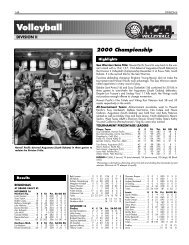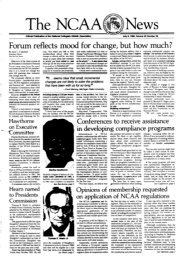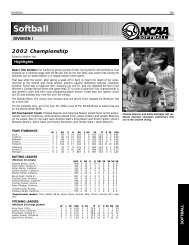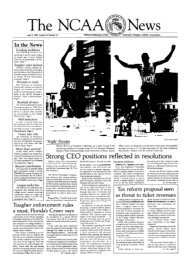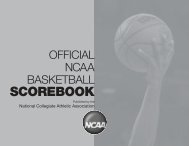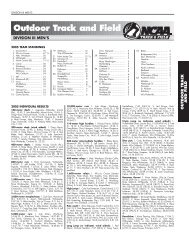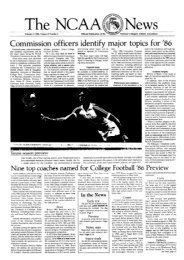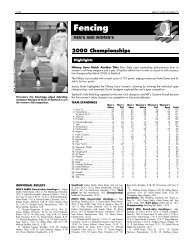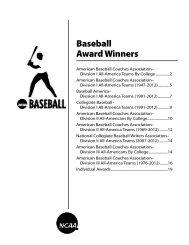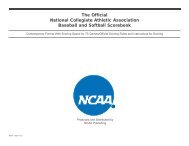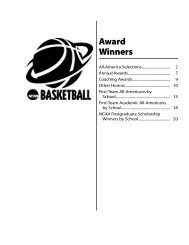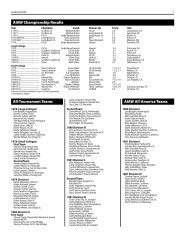Sports Medicine Handbook - NCAA
Sports Medicine Handbook - NCAA
Sports Medicine Handbook - NCAA
Create successful ePaper yourself
Turn your PDF publications into a flip-book with our unique Google optimized e-Paper software.
46<br />
Nutrition and Athletic Performance<br />
dehydration, resulting in loss of<br />
muscular strength and endurance,<br />
decreased aerobic and anaerobic<br />
power, loss of coordination, impaired<br />
judgment, and other complications<br />
that decrease performance and<br />
impair health. These symptoms may<br />
be readily apparent or may not be<br />
evident for an extended period of<br />
time. Many student-athletes have<br />
performed successfully while<br />
experiencing an eating disorder.<br />
Therefore, diagnosis of this problem<br />
should not be based entirely on a<br />
decrease in athletic performance.<br />
Body composition and body weight<br />
can affect exercise performance but<br />
References<br />
1. Nutrition and Athletic Performance.<br />
American College of <strong>Sports</strong> <strong>Medicine</strong>,<br />
American Dietetic Association, and<br />
Dietitians of Canada, Joint Position<br />
Stand, <strong>Medicine</strong> and Science in <strong>Sports</strong><br />
and Exercise. 109:3:509-527, March<br />
2009<br />
2. The Female Athlete Triad. American<br />
College of <strong>Sports</strong> <strong>Medicine</strong> (ACSM)<br />
Position Stand, <strong>Medicine</strong> and Science in<br />
<strong>Sports</strong> and Exercise, 39:10: 1-10 2007.<br />
3. Exercise and Fluid Requirements.<br />
American College of <strong>Sports</strong> <strong>Medicine</strong><br />
(ACSM) Position Stand. 2007<br />
4. Brownell KD, Rodin J, Wilmore JH:<br />
Eating, Body Weight, and Performance in<br />
Athletes: Disorders of Modern Society<br />
Malvern, PA: Lea and Febiger, 1992.<br />
should not be used as the main<br />
criteria for participation in sports.<br />
Decisions regarding weight loss<br />
should be based on the following<br />
recommendations to reduce the risk<br />
of disordered eating.<br />
1. Frequent weigh-ins (either as a<br />
team or individually) are<br />
discouraged unless part of<br />
strategies outlined in Guideline 2c.<br />
2. Weight loss (fat loss) should be<br />
addressed during base or<br />
transition phases.<br />
3. Weight-loss goals should be<br />
determined by the student-athlete<br />
and medical and nutritional<br />
5. Dale, KS, Landers DM. Weight<br />
control in wrestling: eating disorders or<br />
disordered eating? <strong>Medicine</strong> and<br />
Science in <strong>Sports</strong> and Exercise 31:1382-<br />
1389, 1999.<br />
6. Dick RW: Eating disorders in <strong>NCAA</strong><br />
athletics programs. Athletic Training<br />
26:136-140, 1991.<br />
7. Sandborn CF, Horea M, Siemers BJ,<br />
Dieringer KI. Disordered eating and the<br />
female athlete triad. Clinics in <strong>Sports</strong><br />
<strong>Medicine</strong>:19:199-213, 2000.<br />
personnel, with consultation<br />
from the coach.<br />
4. Weight-loss plans should be<br />
individualized and realistic.<br />
For each student-athlete, there may<br />
be a unique optimal body<br />
composition for performance, for<br />
health and for self-esteem.<br />
However, in most cases, these three<br />
values are NOT identical. Mental<br />
and physical health should not be<br />
sacrificed for performance. An<br />
erratic or lost menstrual cycle,<br />
sluggishness or an obsession with<br />
achieving a number on a scale may<br />
be signs that a student-athlete's<br />
health is being challenged.



